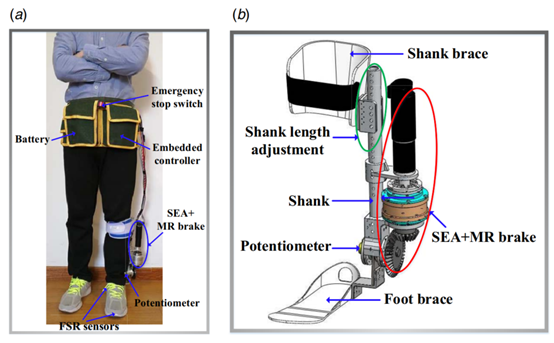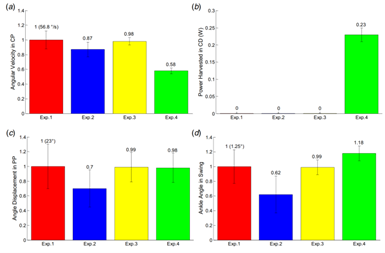The ankle joint helps the body maintain balance, absorbs shocks, and drives the gait cycle. However, patients suffering from strokes, muscular dystrophy, or other damage to the nervous system often develop dyskinesia due to weaknesses in the metatarsal muscles.
Ankle-foot orthoses (AFOs) are wearable medical devices often used to support and correct weak ankle muscles. Researchers at the Hefei University of Technology have developed an ankle orthosis exoskeleton for ankle rehabilitation. This exoskeleton incorporates a flexible shaft motor series to assist the ankle’s dorsal and plantar flexion movements. The exoskeleton is driven by a series elastic actuator (SEA) coupled with a magneto-rheological (MR) brake that allows the SEA to recover energy through regenerative braking.

To evaluate the performance of the ankle-foot orthosis exoskeleton, a series of experiments were conducted on 5 healthy subjects. A total of four experiments were performed under the following conditions:
1)without wearing the AFO,
2)wearing the AFO without power,
3)wearing the AFO with power and the MR brake disabled, and
4)wearing the AFO with power and the MR brake enabled.

In the first experiment, the subjects walked as they would normally and did not wear the AFO. A NOKOV optical motion capture system was arranged in the field and captured the motion of several reflective markers attached to the subject’s lower legs and feet to accurately record the movements of the ankle joint during the gait cycle. During the second, third, and fourth experiments, the subjects wore the AFOs and data was collected by their onboard sensors.

The results of the experiment are shown in the figure above. Experimental results show that the ankle-foot exoskeleton can slow down the wearer’s ankle plantar flexion and regenerate energy during the controlled plantar flexion (CD) stage, which then provides the plantar flexion torque for the wearer’s body to push forward in the energy-consuming plantar flexion (PP) stage. This exoskeleton is effective in assisting the dorsal and plantar flexion of the ankle.

Experimental results: (a) the average ankle angular velocity in the CD stage, (b) the average power in the CD stage, (c) the average ankle angle displacement in the PP stage, and (d) the average ankle angle in the swing phase
Bibliography:
Chen B, Zi B, Wang Z, et al. Development of Robotic Ankle–Foot Orthosis With Series Elastic Actuator and Magneto-Rheological Brake[J]. Journal of Mechanisms and Robotics, 2021, 13(1).